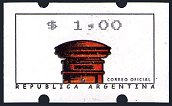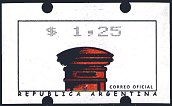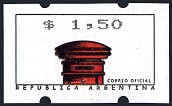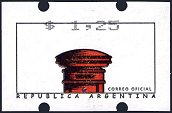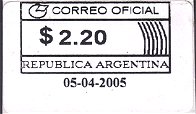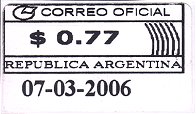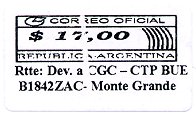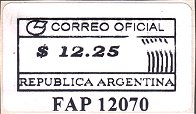| ATMs and variable value stamps in ARGENTINA |
|
 |
| In late 1995, the state-owned Empresa Nacional de Correos y Telégrafos S.A. (ENCOTESA) started a pilot with two PMC (Postage and Mailing Center) postal kiosks made by the US company Unisys. |
 |
Similar machines were in service at some U.S. post offices from February 1994, and were also tested in Taiwan from July 1995.
| The two postal kiosks were installed in the hall of the Buenos Aires central post office, the Correo central, on December 27th 1995, and were in service intermittently for about 3 weeks. Because of various technical and legal problems, the machines were permanently switched off on January 18th 1996. |
 |
The former Palacio de Correos or Correo central in Buenos Aires,
is now the Centro Cultural del Bicentenario |
The postal kiosks worked with coins and allowed the user to print ATMs with 13 different denominations: $0,05-0,10-0,25-0,50-0,75-1,00-1,25-1,50-2,00-2,75-5,00-9,40 & 10,00 - see images below. The face value is printed with black ink, on vertically serrated stamps with a preprinted design, using a dot matrix printer. After the operation, the machines issued a purchase receipt.
 |
The rolls of 3,000 gummed labels were manufactured in the United States by the American Bank Note Company. The design includes a security background with the text CORREO ARGENTINO, in blue, arranged in rows, along with the company logo. The size of the stamps is 22.50 x 24 mm., with straight horizontal edges and vertical perforations size 10. |
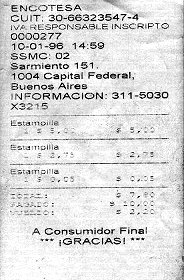 |
The short period that the postal kiosks were in service, as well as the problems of printing the stamps, makes this ATM issue one of the rarest in the world and, therefore, highly valued by collectors. |
| Left, original receipt for the purchase of 3 'estampillas', printed by one of the Unisys postal kiosks. |
 |
Right, first day cover franked with an ATM |
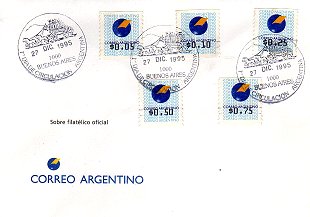 |
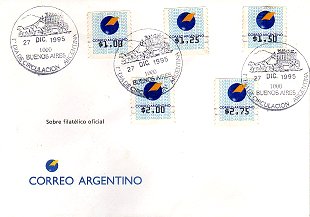 |
 |
| First day covers collection with the 13 values available at the Unisys postal kiosks |
In 1997, the Empresa Nacional de Correos y Telégrafos was privatised, and the provision of services was entrusted to the new company Correos de Argentina S.A., owned by the Grupo Macri - a leading Argentine business group, under the brand name Correo Argentino.
As part of the plan to automate the business network, launched in mid-1998 (see next section), the company decided to test 2 new variable value stamp distributors. One was developed by the national company Cirilo Ayling SAIC, and the other by the well-know Swiss company, Frama. |
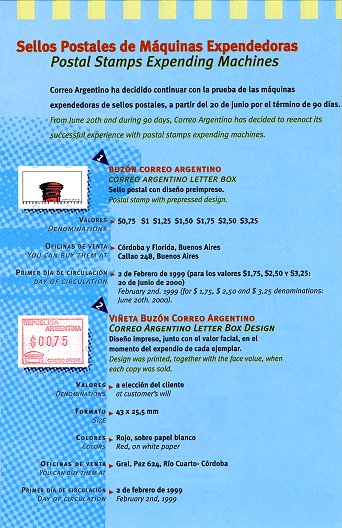 |
| Correo Argentino philatelic leaflet number 869 |
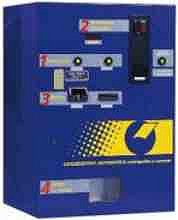 |
The Cirilo Ayling vending machine, TERO model, was programmed with 7 different variable value stamp denominations, and also had the option of selling self-adhesive stamp booklets. It worked with coins and did not issue any receipt.
Correo Argentino installed two TERO distributors in Buenos Aires, in the branches of Plaza General San Martín - Avenida Santa Fe 945, and Avenida de Mayo 649. The pilot began on February 2nd 1999 and lasted until September of that year.
Cirilo Ayling distributors printed the face value on the upper part of the stamps, using a black ink dot matrix printer. The drive mechanism for the rolls of labels was similar to that used by the Klüssendorf distributors, and once issued, the ATMs had 2 semicircular holes at the top edge and two at the bottom. |
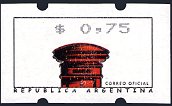 |
The rolls of glossy gummed labels were manufactured by the local company Akian Gráfica Editora, from a design by Ariel Méndez, depicting a Correo Argentino red mailbox. The country name and the words CORREO OFICIAL are also preprinted on the lower part of the stamp.
The size of the ATMs is 43 x 25 mm. (approximately). |
During the first test period, the machines offered the 7 programmed postage rates $ 0,75-1,00-1,25-1,50-2,00-2,25-3,00.
After the first pilot, Correo Argentino decided to conduct a new test with the 2 distributors, relocating them to another 2 postal branches in Buenos Aires - Callao 248, and Cordoba y Florida (right image postmark).
The new trial began on June 20th 2000 and was scheduled to end after three months. However, the machines continued in service, for some further time, until their removal from the post offices in mid 2001. |
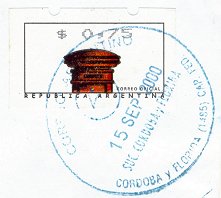 |
| The last 3 high face values programmed, were changed during this second test, to conform with the current postal rates. From June 20th 2000, the 7 scheduled denominations were $ 0,75-1,00-1,25-1,50-1,75-2,50-3,25. |
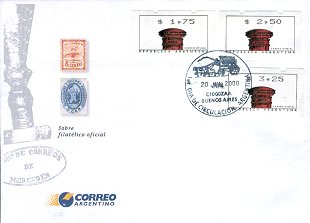 |
| First day cover with the 3 new values programmed from June 20th 2000 |
During the manufacturing process, some drill holes on the rolls of labels were not performed with precision. In the first image, the distance between the drill axis is 22 mm., while the second is 26 mm. The result is that there are ATMs with different heights, cutting errors and imprint displacements.
Besides the Cirilo Ayling distributors, Correo Argentino also tested one FE 1710 vending machine from the Swiss Frama company, similar to those used years ago in countries such as Ireland (1990) and Turkey (1992).
 |
The machine issued ATMs from a roll of white gummed paper. The magenta ink imprint was produced by a print head with a fixed design which included the country's name at the top, and again a mailbox and the text CORREO OFICIAL appeared in the lower part.
The user could obtain ATMs with any face value between $ 00.05 and $ 99.95, in steps of $ 0.05, which was printed in the centre of the label by 4 wheels of digits.
The size of the ATMs is 40 x 33 mm., approximately. |
| The Frama distributor was in service in 3 different Correo branches for different testing periods. Between March 23rd and mid-July 1999 it was in the Flores branch (General Jose Gervasio Artigas, 40), Buenos Aires. From June 20th 2000 and for a few months of 2001 in the General Paz 624 branch, in Río Cuarto, Córdoba. Finally it was sited in the La Plata main post office, where it continued in service until its removal in 2003 due to technical and maintenance problems. |
 |
| The variable value stamps for immediate use |
In July 1998, Correo Argentino launched an ambitious plan to automate the company's business network, with the opening of new multi service branches. This involved the replacement of equipment, the computerization of all operations in the 200 automated Correo post offices (268 in February 2002), and the introduction of new products and services.
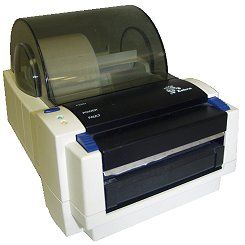 |
This process started at 5 Correo branches in Buenos Aires, - Chacarita, Flores, Plaza Las Heras, Plaza San Martin and Martinez. The branches were connected through a centralized computer system for the management of postal services, and postal counters were provided with computer equipment issuing variable value stamps for immediate use.
The stamps are printed by a Zebra A100 thermal printer (left) connected to the computer equipment. The postal employee weighs the letter or package, selects the destination, the shipment type or service, and the system issues the corresponding variable value stamp (called 'marbete autoadhesivo' in Argentina), which is printed on thermal self-adhesive labels with a preprinted design. |
As usual, because of the conditions of issue and use, these stamps have been systematically ignored by the philatelic publications and despised by most collectors. It does not help that the thermal printing on preprinted labels, makes the mid-term preservation difficult, especially in those areas covered with colour. As in Spain, these are authentic everyday stamps, extensively used for postage, and they make up a very interesting chapter of the recent postal history of the country.
The printers use rolls of 1,500 self-adhesive thermal paper labels with security cuts, printed by flexography. The size is 55 x 38 mm. All the information on these stamps is printed in 3 sections.
Upper section:
- In the first line, the face value in pesos ($), and the date of issue.
- In the second line, a 3-letter code indicating the shipment type or service (see table below). A special code (CM in the picture below) could also appear on some stamps, as well as an indication of any added value (eg, ESCA$ and value in $, corresponding to the additional purchase of a sello postal de alta seguridad, a highly secure stamp for sealing a standard postal box.
Central block (right-aligned text until 2002 - see images below):
- In the first line, and only found on some stamps, a special note indicating the late deposit at the branch (BLK. HORARIO 2 in the image corresponds to a postal piece franked after 17:00).
- In the second line, the weight of the postal item. On some labels it is possible to find additional information (like C.R.$ and the value in $ for the payment on delivery services and / or declared value, for example, and the amount to be charged to the addressee).
- In the third line, the code and name of the postal branch.
The bottom block is printed on the reserved white horizontal strip at the base of the labels. The impression is formed by a linear bar code, which was printed on all stamps until around January 2008, and uses a 26-digit operational code. Since 2008 only this type of code number is printed on the stamps.
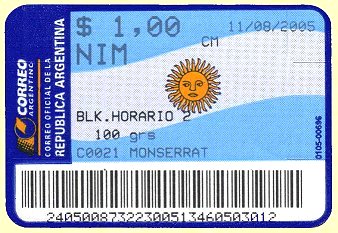 |
Face value |
Date of issue |
| Shipment type |
Added value |
| |
| Note indicating the late deposit at post office |
| Weight of the postal piece |
Other info |
| Code and name of the postal branch |
| Bar code (until January 2008) |
| Operation code |
| Table with some usual shipment and/or service codes |
| CCP |
Carta Certificada Plus
(Domestic Registered letter) |
NCC |
Nacional Carta Certificada
(Domestic Registered letter) |
| CEP |
Carta Expreso Plus
(Domestic urgent letter) |
NCD |
Nacional Carta Documento
(Domestic document letter) |
| CFN |
Carta Factura Nacional
(Domestic Invoice letter) |
NCE |
Nacional Certificado Expreso
(Domestic urgent registered) |
| CRP |
Carta Rápida Plus
(Domestic urgent letter) |
NCP |
Nacional Carta Plus
(Domestic letter) |
| ENI |
Encomienda Internacional
(International packet) |
NCR |
Nacional Carta Rápida
(Domestic urgent letter) |
| ICC |
Internacional Carta Certificada
(International registered letter) |
NCS |
Nacional Carta Simple
(Domestic letter) |
| ICS |
Internacional Carta Simple
(International letter) |
NEC |
Encomienda Nacional
(Domestic packet) |
| IIS |
mm |
NIM |
Nacional Impresos Mailing
(Domestic printed matter) |
| IPC |
mm |
NPM |
Nacional Promo Mailing
(Domestic printed matter) |
| JPC |
Jet Paq Clásico
(International packet) |
NVC |
Nacional Valor Declarado Certificado
(Domestic declared value registered) |
| JPS |
Jet Paq Super-urgente
(International urgent packet) |
NVE |
Nacional Valor Declarado Expreso
(Domestic declared value urgent) |
| JPU |
Jet Paq Urgente
(International urgent packet) |
SPC |
Sobre Protector Certificado
(Protective envelope registered) |
| Ley 23789 |
Working telegram, Law nr. 23789 |
Uso Int + code |
Only for internal-postal use |
 |
| Adjust or calibration printer strip |
8 different label designs have been produced since July 1998 up to the date of writing this article (March 2011). Some of these designs have been used for many years, with some reprints that can be recognized with a detailed study of the labels, although this is a work that remains for more specialized study and is beyond the scope of this introductory article.
| There is no official information from Correo Argentino. Different designs have been manufactured, distributed and used in branches until exhausted. In most cases it is not possible to know the exact dates of first usage, and even less, the last, as the rolls are stored in postal facilities and branches, and are used in no particular order. Therefore, the dates indicated below should be considered approximate and subject to revision, as more information is known about these issues. |
 |
 |
Design 1 |
Yellow background, with no frame line, and a white strip in the lower part.
On the left, the small Correo Argentino logo and vertical text arranged in 3 lines.
Used during the first tests and over the following months. |
 |
Design 2 |
Pink background with blue perimeter frame line and white strip in the lower part.
On the left, the small Correo Argentino logo and vertical text arranged in 3 lines.
On the right, the vertical code, 02-060-0696.
Used from late 1998 and in 1999. |
 |
Design 3 |
Yellow background in different shades, with blue perimeter frame line and white strip in the lower part.
On the left, a larger Correo Argentino logo with orange dotted design. Vertical texts arranged in 4 lines.
On the right, a new vertical code 0105-00696, also printed in all the following designs.
Used possibly from late 1999. There are some reprints. |
 |
Design 4 |
Argentina flag design, with blue perimeter frame line and white strip in the lower part.
On the left, a dark blue block with logo and text CORREO ARGENTINO, a yellow vertical line, and the text CORREO OFICIAL DE LA REPUBLICA ARGENTINA in 2 lines.
Used possibly since 2003. There are some reprints. |
 |
Design 5 |
Identical to the previous design, with the flag of Argentina, blue perimeter frame line and white strip in the lower part. The difference is in the vertical text on the left, CORREO OFICIAL DE LA REPUBLICA ARGENTINA S.A.
(The company was privatised in 1997, and went back to state-owned in late 2003, as Correo Oficial de la República Argentina S.A. - CORASA).
Used possibly from late 2005. There are some reprints. |
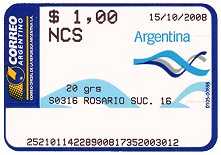 |
Design 6 |
Design with the marca país Argentina (Argentina country brand) logo, with blue perimeter frame line and white strip at in the lower part.
On the left, a dark blue block with larger logo and the text CORREO ARGENTINO, a yellow vertical line, and 1-line of text CORREO OFICIAL DE LA REPUBLICA ARGENTINA S.A.
Used from late 2007. |
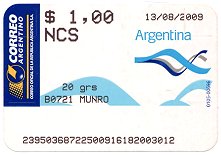 |
Design 7 |
Similar to the previous design with Argentina country brand logo, but WITHOUT a frame line, and lower white strip.
On the left, a dark blue block with the logo and text CORREO ARGENTINO, a yellow vertical line, and text CORREO OFICIAL DE LA REPUBLICA ARGENTINA S.A.
Used since mid-2008. |
| Some reprints with the same design have been produced. We can identify one of them by the roll's adhesive sealing label. The reprint was manufactured in October 2009. The total production was 3,570,000 labels, 2,380 rolls of 1,500 labels. |
 |
2010 marks an interesting turning point for these issues, from the point of view of their study and collecting. After 12 years of issues with basic designs, the first design that we could consider as a commemorative was launched in March 2010, and the first stamps with a special temporary printing came in September.
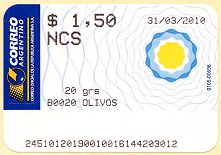 |
Design 8 |
| The first commemorative edition of self-adhesive labels is dedicated to the Bicentenary of the May Revolution. The design by the philatelic department was based on an illustration of Hernán Berdichevsky and Gustavo Stecher, by estudio imagenHB, and shows the Bicentenary logo, with no perimeter frame line, blue block on the left with the information about the postal administration, as in the previous issue. |
The rolls of self-adhesive thermal labels were manufactured by local company Achernar, S.A., which also produced -possibly- most of previous designs.
| Correo Argentino announced the release through the philatelic leaflet 1166, along with the issue of a 'traditional' stamp, on March 6th 2010, dedicated to the same event (right picture and below, left, first day cover). They even established a date of circulation for the variable value stamp, from March 26th 2010, although there was no branch using the label that day, and the first stamps bearing this design were issued a few days later, on March 31st (image below, right). |
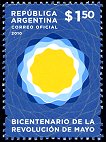 |
With the removal of the bar code imprints, in early 2008, there is space above the numeric code on the bottom of the stamps. So it was thought that use could be made of this space to print some temporary text or special announcement, and some tests were made but which were not continued.
Years later, in mid August 2010, there was a new test in the Buenos Aires central post office and, finally, in early September 2010, the special text 'DETENER LA DISCRIMINACION es clave en la PREVENCION del VIH' (Stop discrimination is key to HIV prevention) was programmed. This text was printed on all variable value stamps issued for about three months, from early September 2010 until December 5th 2010, in all the automated postal branches throughout the country, that were connected to the Correo Argentino central computer system.
Correo Argentino increased some of its postal rates on December 6th 2010. For example, the basic rate for a domestic letter up to 20 g. went from $ 1.50 to $ 2.00. With the reprogramming of postal rates in the software, they also removed this first special text.
A very interesting experience that could continue in future. |
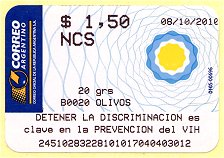 |
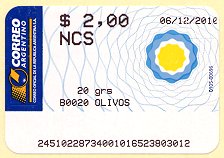 |
 |
Design 9 |
Similar design to number 7, with the marca país Argentina (Argentina country brand) logo.
On the left, a dark blue block with the new CORREO ARGENTINO logo.
Used since September 2013.
Manufactured in rolls of 1,500 self-adhesive thermal paper labels with 6 security cuts and printed by flexography. The size is 55 x 38 mm. The vertical code 0105-00696 printed on most of the designs corresponds to the internal form number for this type of label. |
| Coinciding with the commemoration of the 10th anniversary of the renationalization of Correo Argentino by the Argentine government, the company undertook a major rebranding with a new logotype and visual identity. |
 |
| The images shows two variable value stamps for domestic (NCS - Nacional Carta Simple) and international (ICS - Internacional Carta Simple) letters. |
 |
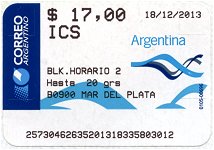 |
More information about the variable value stamps for immediate use, see article >, also published in VARIABLE 15.
| Addendum. The variable value stamps for volume users |
These are variable value stamps, for immediate use, issued in the Correo Argentino mail processing centre, in the city of Monte Grande, south of Buenos Aires. They were used only for the franking of mail, delivered by high volume users, and were usually for letters and publications mailed by the government and large public and private companies.
 |
These stamps were printed by thermal transfer on white self-adhesive labels. The size is 40 x 23-25 mm.
As shown in the pictures below, there are many design variations, imprint types and fonts, but all them include, in addition to face value, the Correo Argentino logo, and the text CORREO OFICIAL and REPUBLICA ARGENTINA. |
Article realized with the collaboration of Eduardo L. Cappa, Guillermo Jalil, Juan Pablo Miri, Carlos A. Redondo, Horacio Rocha, Alejandro E. Spiaggi and the Foro de Filatelia Argentina community.
ATM Web - Spain and Latin American Postal Services: http://www.ateeme.net
© J. Jove - ATEEME. Variable value stamps study group. All rights reserved
This page was created in 2000 and last updated:
20.01.14
. English edition last rewritten by S. Goodman (20.01.2014)
|














